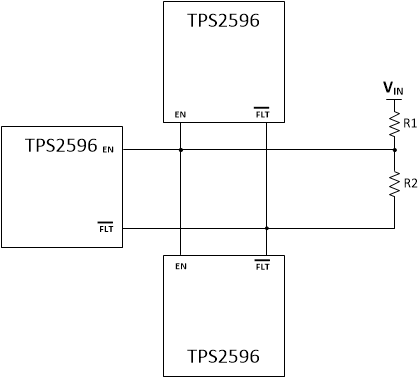SLVSET8A May 2019 – August 2019 TPS2596
PRODUCTION DATA.
- 1 Features
- 2 Applications
- 3 Description
- 4 Revision History
- 5 Device Comparison Table
- 6 Pin Configuration and Functions
- 7 Specifications
-
8 Detailed Description
- 8.1 Overview
- 8.2 Functional Block Diagram
- 8.3 Feature Description
- 8.4 Device Functional Modes
-
9 Application and Implementation
- 9.1 Application Information
- 9.2
Typical Application
- 9.2.1 Precision Current Limiting and Protection for White Goods
- 9.2.2 Design Requirements
- 9.2.3 Detailed Design Procedure
- 9.2.4 Support Component Selection: RFLT and CIN
- 9.2.5 Application Curves
- 9.3 System Examples
- 10Power Supply Recommendations
- 11Layout
- 12Device and Documentation Support
- 13Mechanical, Packaging, and Orderable Information
Package Options
Mechanical Data (Package|Pins)
- DDA|8
Thermal pad, mechanical data (Package|Pins)
- DDA|8
Orderable Information
8.4.3 Enable and Fault Pin Functional Mode 3: Multiple Devices, Self-Controlled
In this mode of operation, the devices are self-controlled (no host present). The EN and FLT pins of multiple devices are shorted together as shown in Figure 52. In this configuration, when any one of the TPS2596xx devices detects a fault, it automatically disables the other TPS2596xx devices in the system.
 Figure 53. Multiple Devices, Self-Controlled
Figure 53. Multiple Devices, Self-Controlled